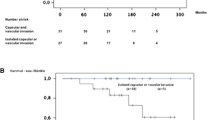Abstract
Background
This study aimed to investigate the association between the extent of vascular invasion (VI) and the outcome of widely invasive follicular thyroid carcinoma (WI-FTC).
Methods
The records of 107 patients with WI-FTC confirmed by surgical specimens from January 2005 to December 2016 were retrospectively reviewed.
Results
Among the 107 patients with WI-FTC, those with a VI of < 4 (n = 62) and ≥ 4 (n = 45) had a 10 year cause-specific survival (CSS) rate of 97.7% and 89.4% (p = 0.008), respectively. Univariate analysis identified M1 (p = 0.001), and the number of VI of ≥ 4 as significant negative prognostic factors for CSS. Multivariate analysis identified M1 (hazard ratio [HR] = 9.366) as independent negative prognostic factor for CSS. Among the 72 patients with M0 WI-FTC, those with a VI of < 2 (n = 33) and ≥ 2 (n = 39) had a 10-year distant metastasis-free survival (DMFS) rate of 96.8% and 56.8% (p = 0.001), respectively. Univariate analysis identified age ≥ 55 years (p = 0.011), presence of VI, the number of VI of ≥ 2, and resection margin status (p < 0.001) as significant negative prognostic factors for DMFS. Multivariate analysis identified the number of VI ≥ 2 (HR = 9.137), and resection margin status (HR = 5.853) as independent negative prognostic factors for DMFS.
Conclusions
It may be unnecessary that WI-FTC with curative resection margin status and a VI of < 2, especially in capsular invasion only, routinely undergo completion thyroidectomy and postoperative ablation.



Similar content being viewed by others
References
Megwalu UC, Moon PK (2022) Thyroid cancer incidence and mortality trends in the United States: 2000–2018. Thyroid 32:560–570
Lloyd RV, Osamura RY, Klo¨ppel G, et al (2017) In: World health organization classification of tumours of endocrine organs [4th Edition], IARC, Lyon, pp. 92–95
D’Avanzo A, Treseler P, Ituarte PH et al (2004) Follicular thyroid carcinoma: histology and prognosis. Cancer 100:1123–1129
O’Neill CJ, Vaughan L, Learoyd DL et al (2011) Management of follicular thyroid carcinoma should be individualised based on degree of capsular and vascular invasion. Eur J Surg Oncol 37:181–185
Ito Y, Hirokawa M, Masuoka H et al (2013) Distant metastasis at diagnosis and large tumor size are significant prognostic factors of widely invasive follicular thyroid carcinoma. Endocr J 60:829–833
Wreesmann VB, Nixon IJ, Rivera M et al (2015) Prognostic value of vascular invasion in well-differentiated papillary thyroid carcinoma. Thyroid 25:503–508
Yamazaki H, Katoh R, Sugino K et al (2022) Encapsulated angioinvasive follicular thyroid carcinoma: prognostic impact of the extent of vascular invasion. Ann Surg Oncol 29:4236–4244
Matsuura D, Yuan A, Wang L et al (2022) Follicular and hurthle cell carcinoma: comparison of clinicopathological features and clinical outcomes. Thyroid 32:245–254
Wong KS, Lorch JH, Alexander EK et al (2019) Prognostic significance of extent of invasion in poorly differentiated thyroid carcinoma. Thyroid 29:1255–1261
Leong D, Gill AJ, Turchini J et al (2023) The prognostic impact of extent of vascular invasion in follicular thyroid carcinoma. World J Surg 47:412–420
Ito Y, Onoda N, Okamoto T (2020) The revised clinical practice guidelines on the management of thyroid tumors by the Japan associations of endocrine surgeons: core questions and recommendations for treatments of thyroid cancer. Endocr J 67:669–717
Ito Y, Hirokawa M, Masuoka H et al (2022) Prognostic factors for follicular thyroid carcinoma: the importance of vascular invasion. Endocr J 69:1149–1156
Shindo H, Kakudo K, Inomata K et al (2021) Additional tissue sampling trials did not change our thyroid practice. Cancers (Basel) 13:1270
Mete O, Asa SL (2011) Pathological definition and clinical significance of vascular invasion in thyroid carcinomas of follicular epithelial derivation. Mod Pathol 24:1545–1552
Kanda Y (2013) Investigation of the freely available easy-to-use software ‘EZR’ for medical statistics. Bone Marrow Transpl 48:452–458
Ito Y, Hirokawa M, Fujishima M et al (2021) Prognostic significance of vascular invasion and cell-proliferation activity in widely invasive follicular carcinoma of the thyroid. Endocr J 68:881–888
Lang W, Choritz H, Hundeshagen H (1986) Risk factors in follicular thyroid carcinomas. A retrospective follow-up study covering a 14-year period with emphasis on morphological findings. Am J Surg Pathol 10:246–255
Collini P, Sampietro G, Pilotti S (2004) Extensive vascular invasion is a marker of risk of relapse in encapsulated non-Hürthle cell follicular carcinoma of the thyroid gland: a clinicopathological study of 18 consecutive cases from a single institution with a 11 year median follow-up. Histopathology 44:35–39
Ghossein RA, Hiltzik DH, Carlson DL et al (2006) Prognostic factors of recurrence in encapsulated Hurthle cell carcinoma of the thyroid gland: a clinicopathologic study of 50 cases. Cancer 106:1669–1676
Matsuura D, Ganly I (2022) New insights on the importance of the extent of vascular invasion. Ann Surg Oncol 29:4024–4025
Acknowledgements
We thank Enago (https://www.enago.jp/) for editing this manuscript.
Funding
No funding was received for this article.
Author information
Authors and Affiliations
Corresponding author
Ethics declarations
Conflict of interest
The authors have nothing to disclose.
Ethical approval
The study was conducted in accordance with the Declaration of Helsinki (as revised in 2013). The protocol used in the present retrospective study was approved by the Ethics Committee of Ito Hospital (Approval No. 389).
Informed consent
Informed consent was waived because of the retrospective nature of the study.
Additional information
Publisher's Note
Springer Nature remains neutral with regard to jurisdictional claims in published maps and institutional affiliations.
Rights and permissions
Springer Nature or its licensor (e.g. a society or other partner) holds exclusive rights to this article under a publishing agreement with the author(s) or other rightsholder(s); author self-archiving of the accepted manuscript version of this article is solely governed by the terms of such publishing agreement and applicable law.
About this article
Cite this article
Yamazaki, H., Sugino, K., Katoh, R. et al. New Insights on the Importance of the Extent of Vascular Invasion in Widely Invasive Follicular Thyroid Carcinoma. World J Surg 47, 2767–2775 (2023). https://doi.org/10.1007/s00268-023-07127-w
Accepted:
Published:
Issue Date:
DOI: https://doi.org/10.1007/s00268-023-07127-w




